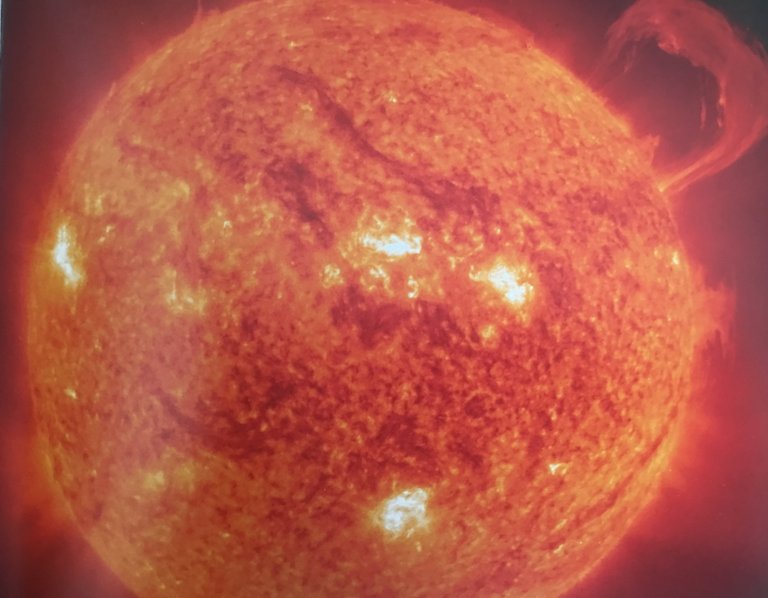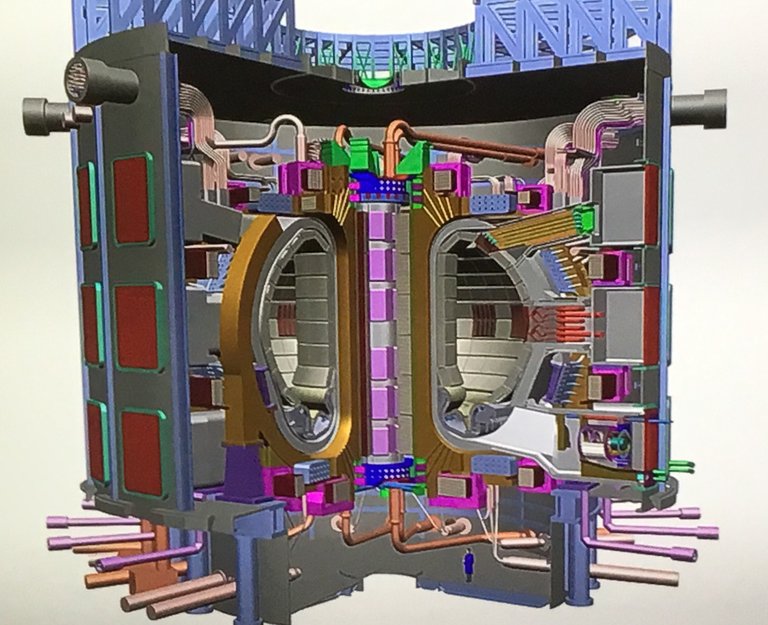Con-Fusion: How The Big Bang Frustrates Progress Toward Practical Nuclear Fusion
CON-FUSION! HOW THE BIG BANG FRUSTRATES PROGRESS TOWARD PRACTICAL NUCLEAR FUSION.
On a warm, sunny day, it would be hard not to notice that there exists a great source of power. If only we could harvest that energy, we could wean ourselves off of fossil fuels. The dream of a cleaner source of energy has inspired research and development into things like photovoltaics and mirrors that focus the sun’s heat in order to create steam that turns turbines. Such plans have shown some progress.

(Lots of energy! Image from Bang! By Brian May, Patrick Moore and Chris Lintott)
There is another dream. This dream does not involve harvesting energy the sun has already produced, but rather recreating the source of all that energy. That dream is nuclear fusion. Unlike nuclear fission, which creates dangerous nuclear waste, some forms of nuclear fusion (the technical term for these is aneutronic fusion) produce no waste at all or if not none than such small amounts it’s truly nothing to worry about. Moreover, whereas fission requires rare elements like uranium for its fuel, nuclear fusion uses boron, which is abundantly available.
It all sounds ideal. But, as with most too-good-to-be-true ideas, nuclear fusion has a serious drawback. Nobody can get it to work. Well, they can. Thermonuclear bombs are fusion devices. But what we have yet to achieve is controlled nuclear fusion that outputs more energy than is inputted in order to trigger fusion in the first place. We keep trying, and have spent billions in the pursuit, but fusion remains only a dream. In fact, it’s become a bit of a joke. It’s the answer to our energy needs that is 50 years away...and always will be.
So what’s going on? Why is nuclear fusion continuing to frustrate us? I think Big Bang Cosmology is partly to blame.
To see the reasoning behind this claim we need to travel back to the 1940s and look at two rival theories of plasma. One theory, which had long been the dominant one, was the brainchild of an Australian called Sidney Chapman. The only thing we need to know about this theory is that it considered electrical currents in space to be impossible. When you have perfect conduction, electrons move so freely that they cancel out the changing electrical fields. If there is no electrical field, there can be no electromagnetic wave either. That’s why analogue car radios lost their signal every time you drove under a metal bridge; radiowaves cannot penetrate a good conductor such as metal.
It was thought that the same thing had to be true of plasma. But one plasma physicist thought differently. His name was Hans Alfven. Alfven’s concept was based on the idea of ‘frozen-in’ field lines. Fellow plasma physicist Eric Lerner explained, “any motion across the field lines would generate an electric field, but a perfect conductor would not allow such a field. So when the plasma moves, the magnetic field lines must ‘move’ as well. Thus waves in plasma would create waves of magnetic field direction”.
Hans Alfven called these waves of changing magnetic fields ‘magnetohydrodynamic waves’ or MHD waves for short. As satellites probed deeper into space, it became increasingly clear that Chapman’s model of empty space being incapable of carrying current was no longer tenable. MHD theory was adopted instead, and this lead mainstream astrophysics to a different assumption. Whereas before they had assumed perfect insulation, now they assumed perfect conductivity. No electrical fields are possible in such a plasma, because if you have perfect conductivity energy dissipates instantly and no voltage accumulates. It would be like a power station that has no insulators, it just won’t work.
Astrophysicists were not the only ones to embrace MHD theory. The dream of nuclear fusion had already begun and by the 50s we were discovering what is known all too well today: It is damn hard to achieve. The problem was that the plasma refused to behave itself. Whenever it was squeezed, it would twist up and hurl itself against the walls of its container. The scientists looked for a way to tame it, and thought the answer might lie in Alfven’s MHD model. For one thing, the problem was an MHD instability, so it was hoped that Alfven’s model of waving, frozen-in fields might yield a solution. Also, very elegant mathematical forms could be produced from MHD theory, which was why it was so popular with astrophysicists.
The search for viable nuclear fusion assuming the validity of frozen-in magnetic fields led to the development of the Tokamak, a gigantic machine that relies on very large and extremely expensive magnets to stabilise the plasma. That’s not the only drawback. Another problem is that we know of no external magnetic device able to contain plasma temperatures above 300 million degrees, which sounds hot but is low by fusion standards. In fact, there’s only one fuel that can fuse at such temperatures, and that’s deuterium-tritium. Unfortunately, it produces nearly all its energy in the form of neutrons, which results in radioactivity. It’s a lot less than you get from conventional nuclear fission, but still enough to require considerable safety precautions.

(A Tokamak. Image from Wikimedia commons)
The Tokamak concept has had billions poured into it and is by far the main focus of mainstream nuclear fusion. ITER, a Tokamak-style device, is supposed to be in operation by 2030. But don’t be surprised if we are still joking that nuclear fusion is 50 years away, even then.
Everyone seemed to have faith in the MHD model. Well, almost everyone. The father of the idea, Hans Alfven, had developed serious doubts over its universal applicability. He believed it was wrong to assume perfect conductivity in all plasmas. In the early 1960s, he developed a new model that showed how as plasma moves slowly past magnetic fields, significant electrical fields are generated and not shorted out. That’s not to say that MHD theory is never applicable. It does apply to very dense plasmas such as within stars. But, for most plasmas, it’s just not valid.
According to Alfven, “originally, I thought the frozen-in concept was very good pedagogically. But in reality, it was a dangerous pseudo-pedagogical concept that makes you believe you understand a phenomenon when you have drastically misunderstood it”.
Being his idea in the first place, Alfven thought he could explain the limitations of MHD theory and gain acceptance for his more valid newer theories, with their galactic-scale filaments and currents. But mainstream astrophysics just didn’t want to know. The MHD approach fitted too well with their increasing use of a mathematically rigorous, deductive approach. Moreover, they had moved onto textbooks by people like S. Chandrasaker, whose knowledge of plasma was derived entirely from theory and not years of laboratory work as was the case with Alfven.
By the 1960s, Alfven still had no luck in convincing astrophysicists that frozen-in field lines was more pseudoscience than science. His work on inhomogeneous plasma was completely overshadowed by his self-rejected MHD model, and not only were his ideas on how electromagnetism’s effect on plasma as a key influence on the evolution of the universe rejected, researchers attempting to achieve nuclear fusion stuck dogmatically to the MHD model too. This is what markedly slowed fusion research.
The final irony came in the 1970s when Alfven received a Nobel prize….for the development of magnetohydrodynamics and the concept of frozen lines of magnetic force! Alfen used his acceptance speech to once again point out the limitations of this theory, saying plasma “does not ‘understand’ how beautiful the theories are and absolutely refuses to obey them”. But nobody listened, and even today almost all attempts at fusion try and tame plasma instability using elegant but pseudoscientific models. Perhaps it is unsurprising, then, that they are getting nowhere despite the enormous amounts of money they have received in funding.
Coming up in Part Two, a different way of doing nuclear fusion...that mysteriously lacks funding.
REFERENCES
“The Big Bang Never Happened” by Eric Lerner